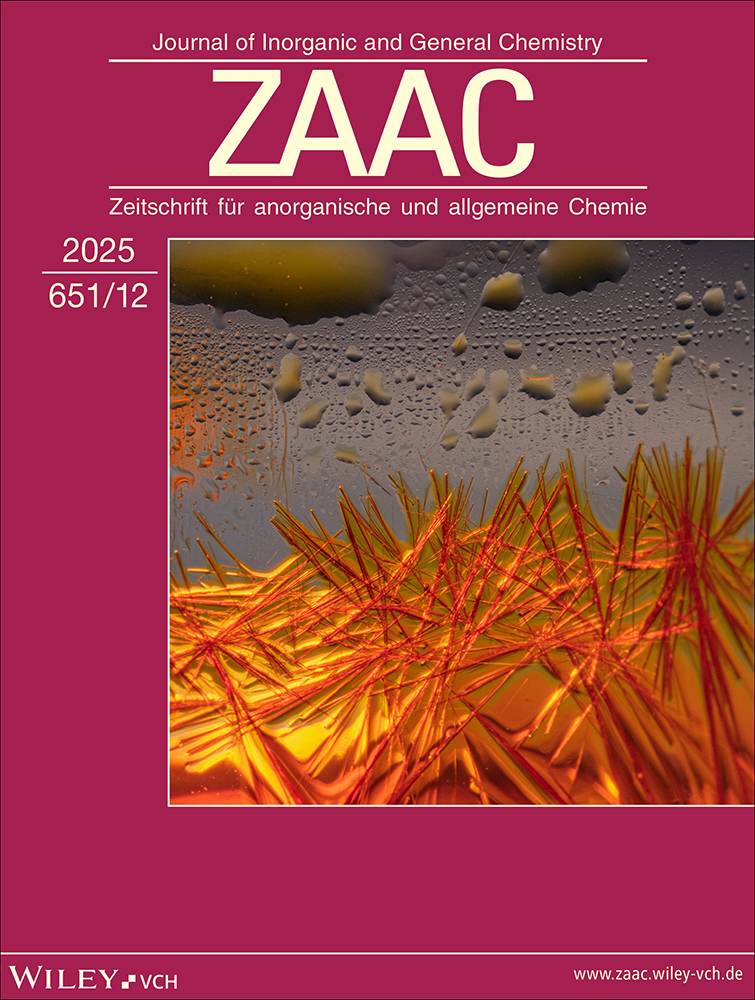New Suberato-bridged Supramolecular Layers: Crystal Structure of [Cu2(phen)2(C8H12O4)2] · 3 H2O with phen = 1,10-phenanthroline
Abstract
enThe reaction of CuCl2 · 2 H2O, 1,10-phenanthroline (phen), suberic acid and Na2CO3 in a CH3CN–H2O solution yielded blue needle-like crystals of [Cu2(phen)2(C8H12O4)2] · 3 H2O. The crystal structure (monoclinic, P21/n, a = 10.756(2) Å, b = 9.790(2) Å, c = 18.593(4) Å, β = 91.15(3)°, Z = 2, R = 0.043, wR2 = 0.1238) consists of suberato-bridged  [Cu2(phen)2(C8H12O4)4/2] layers and hydrogen bonded H2O molecules. The Cu atoms are coordinated by two N atoms from one bidentate chelating phen ligand and three carboxyl O atoms from different suberato ligands to form distorted [CuN2O3] square-pyramids with one carboxyl O atom at the apical position (d(Cu–N) = 2.017(2), 2.043(3) Å, basal d(Cu–O) = 1.936(2), 1.951(2) Å and axial d(Cu–O) = 2.389(2) Å). Two [CuN2O3] square-pyramids are condensed via a common O–O edge to a centrosymmetric [Cu2N4O4] dimer with the Cu…Cu distance of 3.406(1) Å indicating no interaction between Cu atoms. The resultant [Cu2N4O4] dimers are interlinked by the tridentate suberato ligands to form
[Cu2(phen)2(C8H12O4)4/2] layers and hydrogen bonded H2O molecules. The Cu atoms are coordinated by two N atoms from one bidentate chelating phen ligand and three carboxyl O atoms from different suberato ligands to form distorted [CuN2O3] square-pyramids with one carboxyl O atom at the apical position (d(Cu–N) = 2.017(2), 2.043(3) Å, basal d(Cu–O) = 1.936(2), 1.951(2) Å and axial d(Cu–O) = 2.389(2) Å). Two [CuN2O3] square-pyramids are condensed via a common O–O edge to a centrosymmetric [Cu2N4O4] dimer with the Cu…Cu distance of 3.406(1) Å indicating no interaction between Cu atoms. The resultant [Cu2N4O4] dimers are interlinked by the tridentate suberato ligands to form  [Cu2(phen)2(C8H12O4)4/2] layers parallel to (101). These are assembled via π-π stacking interactions into 3D network with H2O molecules in the tunnels extending in the [010] direction.
[Cu2(phen)2(C8H12O4)4/2] layers parallel to (101). These are assembled via π-π stacking interactions into 3D network with H2O molecules in the tunnels extending in the [010] direction.
Abstract
deNeue suberat-verbrückte supramolekulare Schichten. Kristallstruktur von [Cu2(phen)2(C8H12O4)2] · 3 H2O mit phen = 1,10-Phenanthrolin
Die Reaktion von CuCl2 · 2 H2O, 1,10-Phenanthrolin (phen), Korksäure und Na2CO3 führt in einer Acetonitril/Wasser-Lösung zu blauen, nadelförmigen Kristallen von [Cu2(phen)2(C8H12O4)2] · 3 H2O. Die Kristallstruktur (monoklin, P21/n, a = 10.756(2) Å, b = 9.790(2) Å, c = 18.593(4) Å, β = 91.15(3)°, Z = 2, R = 0.043, wR2 = 0.1238) besteht aus suberato-verbrückten Schichten  [Cu2(phen)2(C8H12O4)4/2] und wasserstoff-verbrückten Wassermolekülen. Die Kupferatome werden durch zwei Stickstoffatome eines zweizähnig-chelatisierenden phenLiganden und drei Carboxyl-Sauerstoffatomen unterschiedlicher Suberat-Liganden in Form einer verzerrten quadratischen Pyramide [CuN2O3] koordiniert, wobei ein Carboxyl-Sauerstoffatom die apikale Position einnimmt (d(Cu–N) = 2.017(2), 2.043(3) Å, basal d(Cu–O) = 1.936(2), 1.951(2) Å und axial d(Cu–O) = 2.389(2) Å). Zwei quadratische Pyramiden [CuN2O3] werden über eine O–O-Kante zu einem zentrosymmetrischen Dimer [Cu2N4O4] verknüpft, mit einem Cu…Cu-Abstand von 3,406(1) Å. Die Dimeren werden durch dreizähnige Suberat-Liganden zu Schichten
[Cu2(phen)2(C8H12O4)4/2] und wasserstoff-verbrückten Wassermolekülen. Die Kupferatome werden durch zwei Stickstoffatome eines zweizähnig-chelatisierenden phenLiganden und drei Carboxyl-Sauerstoffatomen unterschiedlicher Suberat-Liganden in Form einer verzerrten quadratischen Pyramide [CuN2O3] koordiniert, wobei ein Carboxyl-Sauerstoffatom die apikale Position einnimmt (d(Cu–N) = 2.017(2), 2.043(3) Å, basal d(Cu–O) = 1.936(2), 1.951(2) Å und axial d(Cu–O) = 2.389(2) Å). Zwei quadratische Pyramiden [CuN2O3] werden über eine O–O-Kante zu einem zentrosymmetrischen Dimer [Cu2N4O4] verknüpft, mit einem Cu…Cu-Abstand von 3,406(1) Å. Die Dimeren werden durch dreizähnige Suberat-Liganden zu Schichten  [Cu2(phen)2(C8H12O4)4/2] verknüpft, die parallel (101) verlaufen. π-π-Wechselwirkungen führen zu einem dreidimensionalen Netzwerk; Wassermoleküle sind in Tunnels, die in Richtung [010] verlaufen, eingelagert.
[Cu2(phen)2(C8H12O4)4/2] verknüpft, die parallel (101) verlaufen. π-π-Wechselwirkungen führen zu einem dreidimensionalen Netzwerk; Wassermoleküle sind in Tunnels, die in Richtung [010] verlaufen, eingelagert.




